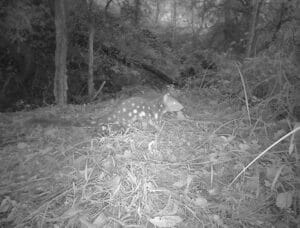Dendrobium speciosum var. hilli is a popular garden plant because of its impressive floral display. Healthy, nursery raised specimens can be purchased from Orchid societies and registered nurseries without damaging wild populations.

Dendrobium speciosum var. hilli
Photo credit:Fred Fetherston
The two varieties appear fairly similar to the uninitiated, with key differences occurring in the thickness of the stems, root formation and overall size; as well as differences in the number and arrangement of flowers on the inflorescence (being far greater in the northern species). Just to confuse things, it is thought that the two varieties hybridise with each other, as well as other species of Dendrobium. Indeed, some orchid enthusiasts pride themselves on creating new varietals by facilitating the cross pollination of varieties/species.
Researchers are looking for molecular markers to identify genetic diversity, population structure and gene flow within and between populations of Dendrobium speciosum. Genetic data may also inform the phylogeny of the subspecies. Genetic data is adding to our understanding of the natural world, which has traditionally been based largely on morphological and ecological field studies.
D. speciosum, like many native orchid species, has a very specific relationship to an insect pollinator. As with most orchid species, D. speciosum offers a reward (usually nectar or pseudo nectar); or it presents a tricky arrangement on the floral tube that attracts the pollinator without provision of a reward (deception). As such, timing of floral display (anthesis = flower opening) is imperative for successful pollination. The pollination of Dendrobium speciosum is facilitated by native bees and honeyeaters (attracted to the nectar), wasps (attracted by floral scents or by deception), as well as flies and the ‘Dendrobium Beetle’ Stethopachys formosana (attracted to nectar, and may lay eggs in the floral structure and pseudobulbs).
Pollinators from these insect groups are guided to the nectar source by purplish markings on the labellum, which also may act as a landing-pad for pollinators. As the insect moves deeper into the floral tube, they must brush past the column which deposits pollen sacs (pollinia) onto the body of the pollinator. When the pollinator visits a different flower, the pollinia are then dislodged onto the stigma of this flower, facilitating fertilisation.
Successful pollination, therefore, is intrinsically linked to the abundance and diversity of pollinators, as well as the timing of flowering in relation to the activity of key pollinator groups. As such, changes in vegetation structure, temperature and rainfall patterns may have significant impacts on the flowering process, and the abundance of pollinators. This means that human induced climate change is predicted to impact the long term survival of orchids globally, including local populations of Rock and King Orchids.
Other concerning threats to this, and other native orchid species include:
Habitat loss and fragmentation
Weed incursion
Altered fire regimes
Illegal collection
Hybridisation
Loss of insect diversity from chemical use
Viruses and diseases especially from feral “epicattleya” orchids.
Why not grow some rock or king orchids in your garden or revegetation project? Healthy, nursery-raised plants of your local varieties can be purchased from Orchid Societies and registered nurseries without disturbing bush plants. Be careful because many plants advertised online have been taken illegally from the bush, or are being sold because they have disease problems.




